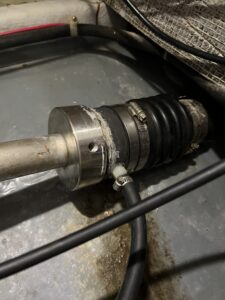Prepping Your Boat For Spring Cruising (Cont.)
After making my initial inspections and completing an overnight sea trial three serious issues presented themselves. In this issue I discuss the most serious and the most complicated problem, leaking propeller shaft seals.
Mai Tai is fitted with PSS dripless shaft seals. While they have performed well over the years it is not surprising that they have finally required attention. In fact, they have never been changed or even serviced in 32 years.

Dripless Shaft Seal
Dripless Shaft Seal Basics
Dripless shaft seals operate on a pretty simple design. Two discs, one rotating stainless steel and one stationary graphite, are forced together by outside water pressure through a sealed rubber bellows.
Check out this link for a pretty good diagram. Scroll down a bit to the description below the sales part.
There are a few reasons these seals begin to leak. And, it may be possible to repair the leak without hauling the boat out of the water. But, first consider some of the basics.
The PSS system manufacturer recommends replacing the seals after 6 years of service. If, like Mai Tai, your seals are substantially older you can try to correct the problem but don’t get your hopes up.
Dripless Shaft Seal Checks
It is possible that something has gotten between the two discs. Its not likely but you can try to clean up the surfaces by inserting a folded piece of 600 grit sandpaper between the discs and make a few passes all around the discs. Water will leak into the bilge so be prepared for that.
My experience did not solve the problem. So, the next attempt to discover the reason for the leak as to do with engine/shaft alignment. There are a few videos that demonstrate the process. The best one I found is below. I found this process to be extremely difficult to gauge the shaft alignment in the log. And, when I disconnected the shaft from the transmission I found no misalignment.
This next video demonstrates the process for measuring the direction the engine needs to move.
Beware when decoupling the shaft. It may tend to drop breaking the seal and allowing a massive amount of water into the bilge.
Other Checks and Maintenance Tips
Regular checks of these seals should include the condition of the clamps and the rubber bellows. But, the most important check that could lead to a catastrophic failure and that is the little hose connected to the stationary graphite disc. It’s function is to cool and lubricate the two discs.
If the friction between the two discs is not controlled then excessive heat will develop. The result can force the stationary graphite disc to spin on the shaft too. If that happens the bellows will be destroyed.
It is recommended that the cooling water delivery be verified regularly. At least once or twice a year. To do this start the engine and while it’s idling pull the cooling water hose off the graphite disc and observe the water flow. Recommended flow should be about one gallon per minute.
There’s not much more you can do to try to stop a leak with the boat in the water. You can visit this website for a pretty good write-up on maintaining your dripless seals.
We’ve ordered new seals and are planning to haul Mai Tai very soon and I’ll keep you updated as we get into it.
Until next time . . .
Recent Comments